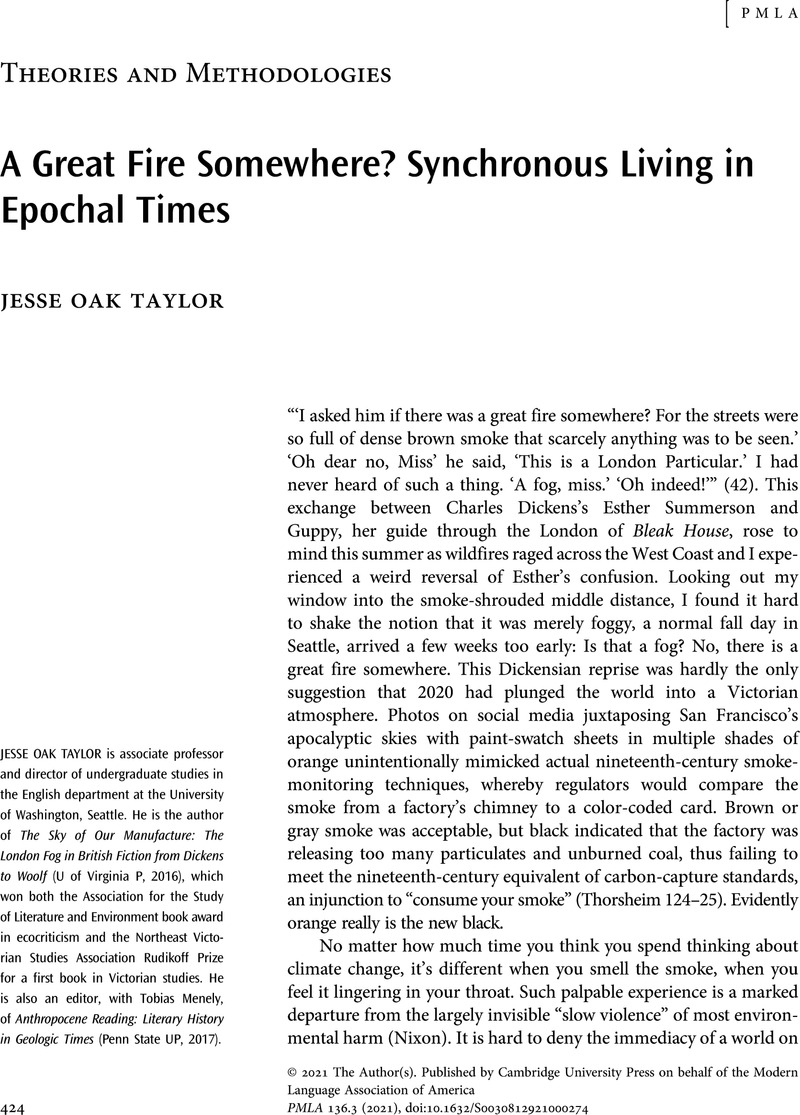No CrossRef data available.
Article contents
A Great Fire Somewhere? Synchronous Living in Epochal Times
Published online by Cambridge University Press: 25 June 2021
Abstract
An abstract is not available for this content so a preview has been provided. Please use the Get access link above for information on how to access this content.

- Type
- Theories and Methodologies
- Information
- Copyright
- Copyright © 2021 The Author(s). Published by Cambridge University Press on behalf of the Modern Language Association of America
References
Works Cited
Babbage, Charles. The Ninth Bridgewater Treatise: A Fragment. 2nd ed., John Murray, 1838.Google Scholar
Baucom, Ian. History 4° Celsius: Search for a Method in the Age of the Anthropocene. Duke UP, 2020.Google Scholar
Bonneuil, Christophe, and Fressoz, Jean-Baptiste. The Shock of the Anthropocene: The Earth, History, and Us. Translated by Fernbach, David, Verso, 2016.Google Scholar
Conrad, Joseph. “Henry James: An Appreciation.” 1916. Notes on Life and Letters, edited by Stape, J. H., Cambridge UP, 2004, pp. 5–20.Google Scholar
Cusick, Daniel. “You Can Taste Climate Change in This Awful Beer.” Scientific American, 28 Apr. 2021, www.scientificamerican.com/article/you-can-taste-climate-change-in-this-awful-beer/.Google Scholar
Dimock, Wai Chee. “A Theory of Resonance.” PMLA, vol. 112, no. 5, Oct. 1997, pp. 1060–71.Google Scholar
Ghosh, Amitav. The Great Derangement: Climate Change and the Unthinkable. U of Chicago P, 2016.CrossRefGoogle Scholar
Haraway, Donna. Staying with the Trouble: Making Kin in the Cthulucene. Duke UP, 2016.Google Scholar
@latifnasser (Latif Nasser). “And yes, since most African Americans vote and have voted Democrat. …” Twitter, 2 Nov. 2020, twitter.com/latifnasser/status/1323338797795430401.Google Scholar
@latifnasser (Latif Nasser). “The Black Belt story is painful but profound. …” Twitter, 2 Nov. 2020, twitter.com/latifnasser/status/1323341552941371392.Google Scholar
@latifnasser (Latif Nasser). “Eventually they turn to chalk. …” Twitter, 2 Nov. 2020, twitter.com/latifnasser/status/1323336592665190400?lang=en.Google Scholar
@latifnasser (Latif Nasser). “To start, let's go back to the Cretaceous. …” Twitter, 2 Nov. 2020, twitter.com/latifnasser/status/1323336023686799360?lang=en.Google Scholar
Lewis, Simon L., and Maslin, Mark A.. “Defining the Anthropocene.” Nature, vol. 519, Mar. 2015, pp. 171–80.CrossRefGoogle ScholarPubMed
Lewis, Simon L., and Maslin, Mark A.. The Human Planet: How We Created the Anthropocene. Yale UP, 2018.Google Scholar
Luciano, Dana. “Romancing the Trace: Edward Hitchcock's Speculative Ichnology.” Menely and Taylor, pp. 96–116.Google Scholar
Malm, Andreas. Fossil Capital: The Rise of Steam Power and the Roots of Global Warming. Verso, 2016.Google Scholar
Masco, Joseph. “Bad Weather: On Planetary Crisis.” Social Studies of Science, vol. 40, no. 1, 2000, pp. 7–40.CrossRefGoogle Scholar
McKibben, Bill. “Why Bill McKibben Sees Rays of Hope in a Grim Climate Picture.” Interview by Elizabeth Kolbert, Yale Environment 360, 30 Apr. 2019, e360.yale.edu/features/why-bill-mckibben-sees-rays-of-hope-in-a-grim-climate-picture.Google Scholar
Menely, Tobias, and Taylor, Jesse Oak, editors. Anthropocene Reading: Literary History in Geologic Times. Penn State UP, 2017.Google Scholar
Nixon, Rob. Slow Violence and the Environmentalism of the Poor. Harvard UP, 2011.CrossRefGoogle Scholar
Parker, Geoffrey. Global Crisis: War, Climate Change, and Catastrophe in the Seventeenth Century. Yale UP, 2013.Google Scholar
@ReverendWarnock (Raphael Warnock). “As a Black teenager. …” Twitter, 17 Dec. 2020, twitter.com/reverendwarnock/status/1339647561683136514?lang=en.Google Scholar
Robinson, Kim Stanley. “A Sci-Fi Author's Boldest Vision of Climate Change: Surviving It.” Interview by Russell Gold, The Wall Street Journal, 6 Feb. 2020, www.wsj.com/articles/a-sci-fi-authors-boldest-vision-of-climate-change-surviving-it-11581004678.Google Scholar
Taylor, Jesse Oak. “Globalize.” Veer Ecology: A Companion for Environmental Thinking, edited by Cohen, Jeffrey Jerome and Duckert, Lowell, U of Minnesota P, 2017, pp. 30–43.CrossRefGoogle Scholar
Thorsheim, Peter. Inventing Pollution: Coal, Smoke, and Culture in Britain since 1800. U of Ohio P, 2006.CrossRefGoogle Scholar
Tsing, Anna L., et al. , editors. Feral Atlas: The More Than Human Anthropocene. Stanford UP, 2020, www.feralatlas.org.CrossRefGoogle Scholar
Underwood, Ted. Why Literary Periods Mattered: Historical Contrast and the Prestige of English Studies. Stanford UP, 2013.CrossRefGoogle Scholar




